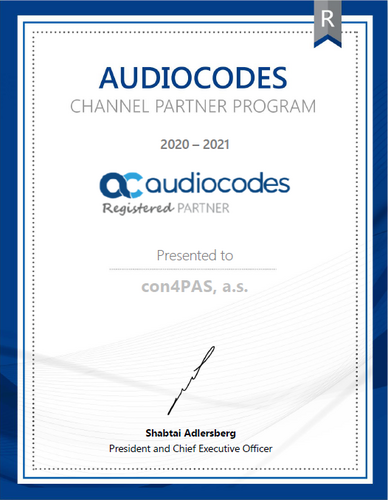
Ján Ferjo, Business Development Director at con4PAS, focuses on the topic of contact centres in a follow-on to his insight into cloud projects. He looks back to the time when SAP first incorporated multi-channel communication solution into its portfolio, how the world of communication has evolved and what trends dominate it today.
In one of my latest editorials about my experience with cloud projects, I only touched on solutions from the SAP portfolio – specifically business and service processes. Very often, however, the evolution of digital transformation in most customers continues towards the consolidation of input and output channels into unified multi-channel communication. Today I would like to focus on this topic and our experience from projects we have already implemented.
Since the early days of SAP CRM, the solution has been designed to handle inbound calls and was ready for the integration of third-party solutions. Around 2006, SAP started becoming more customer-oriented and began to add new solutions to its portfolio. One of the first solutions to consolidate multichannel communication into a single (unified) form was the solution by Wicom, which SAP acquired in 2007 together with the company’s development laboratories in Espoo, Finland (link to the press release here). This move significantly expanded the business and especially service scenarios in SAP CRM by making the delivery of the customer service solution complete and independent of any need for integration of third-party telephony.
At con4PAS, we have been implementing CRM-based on-premise solutions since 2003, and integration with existing telephony has been part of some of the projects we have delivered. With the acquisition of Wicom’s solutions, SAP has transformed the concept of customer service to a complete delivery, from the processing of inbound/outbound calls to the resolution of customer queries or the implementation of telemarketing campaigns. This concept was quickly put into practice in the Czech Republic and companies such as Pražská energetika, Pražská plynárenská, and in recent years Vodňanská drůbež have been successfully using these scenarios to this day.
In the last few years, the world of communication has shifted towards instant messaging, social media, the use of chatbots, voicebots, and other progressive methods using artificial intelligence to various degrees. This change brings new companies to the market – companies that focus primarily on effective communication processing and interaction with existing solutions in the field of classic CRM systems and processes. One such fast-growing company is Sinch, which dynamically expands its portfolio of multichannel communications and consolidates various forms of communication into a single solution. Due to this, in 2019, SAP and Sinch reached an agreement on the purchase and integration of the SAP Digital Interconnect solution into Sinch’s portfolio (link to the press release here) while maintaining the direct links that do not require any third-party integration interfaces for the Sinch solution (Sinch Contact Pro on SAP Store).
From this point on, Sinch has been rapidly developing its purchased solutions in both the on-premise and cloud versions, which are fully integrated into the classic SAP CRM on-premise solution, as well as SAP Cloud for Customer. Due to the interconnectedness of these CRM and telephony systems and our previous experience in the field of contact centers, it was natural for us to establish cooperation with Sinch in order to continue to provide full-fledged solutions to our customers. Today, we can be proud of our live implementation of these solutions, e.g. in Al Salehiya, a medical equipment wholesaler in the MENA market.
We have extensive experience with contact center solutions dating back to 2011. The vast majority of these projects are associated with the implementation of CRM solutions, where the contact center consolidates input and output channels into a single communication form. This means that the operator responding to an incoming phone call, email, or online chat always has access to the same full customer information and the customer’s history, helping them resolve the reason for initiating the contact (enquiry, complaint, response to a marketing campaign, etc.) as efficiently as possible.
It is quite interesting to observe the changes in the behaviour of users using each communication channel. Currently, approximately 89% of users prefer to communicate via instant messaging over other channels with relatively interesting content.
What do customers want from their in-message interactions?
Source: Sinch – Brave New World – Customer Experience in 2022
Our experience shows that the changes in user behaviour are region-dependent and, for example, in the MENA region, there is a strong preference for communication using apps like WhatsApp over traditional phone calls, while using the telephone channel is still prevalent in Europe according to the data so far.
Another interesting trend is the use of the telephone for communication with doctors on various topics, as shown in the following figure.
Source: Sinch – Brave New World – Customer Experience in 2022
As I have already indicated, individual companies take different approaches to communication with their customer tribe depending on which channels are prevalent in their external communication. For most, however, this involves voice communication and email in the first phase, followed by communication via social media such as WhatsApp or FB messenger in the later phases. To a lesser extent, additional channels such as Twitter and Facebook are also used.
However, we are increasingly addressing customer requirements regarding the use of artificial intelligence in customer communication, which leads to the deployment of ChatBot and VoiceBot solutions to increase automated customer service at first contact and reduce dependence on human operators. The trend suggests that this type of communication, which keeps gaining momentum, will become prevalent in the near future, and any company considering innovations in customer service will have to consider deploying such solutions sooner or later.
![]()
Interested in the article and want to know more? |
Read more about the solutions in Customer Management line of business and their respective success stories.
Sinch Contact Pro SAP CRM SAP C4C Intelligent Sales Add-On Dynamic Visit Planning Add-On Service Agent Console Add-On SAP CPQ

